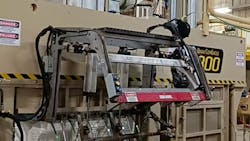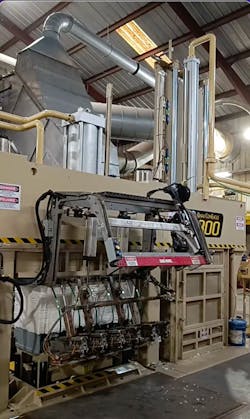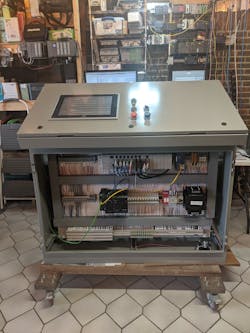Upgrading the Controls for a Machine Builder’s Cotton Press
It is believed that cotton production originated more than 7,000 years ago. As a key component in global textiles for millennia, the various growing, harvesting and processing techniques have varied greatly. In contrast, the cotton gin and cotton baler (or baling press) machines have merely existed for about 200 years. A cotton gin separates out cotton fibers from seeds, while the press condenses and bales cotton lint and fibers for shipment (Fig. 1).
Equipment like a cotton press is built to be mechanically serviceable for decades. But with global cotton production expected to be around 116 million bales in 2023, it is more important than ever for even legacy machines to be retrofitted to modern automation standards, ensuring reliable operation to meet the world’s textile demand. Recently, Design Automated Controls, a systems integrator (SI) that works with clients of all sizes from multiple industries, was tasked with upgrading the controls for a machine builder’s cotton press.
READ MORE: System Integrators: The Key to Project Success
A Specification for Productivity
While the mechanics of the cotton press have been well-tested and refined over the years, a digital control platform with modern capabilities is a new consideration. With ever-increasing functionality available, this particular machine builder desired to swap out another manufacturer’s legacy controller in favor of the Productivity2000 micro-modular programmable logic controller (PLC) family from AutomationDirect.
This PLC platform consists of controllers that are modular, rack-based and offer a plethora of input/output (I/O) options with substantial processing power suitable for complex operations (Fig. 2). The hardware is complemented by a full suite of free programming software.
The request for the specific controller was driven primarily by the end-user, as the cotton press owner/operator had experience with the platform performing well in another machine at their facility.
Initially, the SI questioned the machine builder’s request as the SI had no prior experience working with this machine control system and was not familiar with the Productivity platform. However, the desire to satisfy the customer prevailed and the SI began the process of converting the program from the legacy controller to the Productivity platform.
READ MORE: The PLC Breaks Out!
Try and Try Again
As is often the case when things are trialed for the first time, some unforeseen circumstances arose. The legacy program obtained from the cotton press had been in service for many years and undergone a multitude of design changes. In fact, the version supplied to the SI turned out to be outdated and not fully compatible with the machine and some modifications it had undergone. Unfortunately, this was discovered only when it was time to commission the new machine, so a fix was needed fast.
The SI took this in stride and began evaluating options. After consulting with an experienced mechanic who was extremely familiar with the particular characteristics of the cotton press, it was decided to discard the original program and start from scratch. This turned out to be a good thing, for several reasons.
Aside from not being compatible with the latest machine functionality, the customer had worked with multiple programmers on a contract basis over the years to develop the original program. The program contained many idiosyncrasies and styles, was difficult to follow, and not optimized for performance. Fortunately, the new software platform proved to be easy to master. Within a few days, the new code was written and the machine was commissioned.
In addition to having an intuitive interface, the PLC platform proved to be powerful. So much so that when the machine was up and running the customer remarked that it was, “the best and smoothest running version to date.”
READ MORE: Optimizing Linear Motion Solutions Using Hybrid Automation Systems
Visualizing the Process
The primary operator touchpoint for any modern digitally controlled machine is the visualization interface on the control console, sometimes in conjunction with traditional devices like pushbuttons. Customer specifications may dictate that specific products be used, such as human machine interfaces (HMIs).
While this may limit the choices available to systems integrators when they are developing the system architecture for the control system, they need to be prepared to select products from the allowable list that will perform and interconnect well (Fig. 3).
Although there are several advantages—and often streamlined communications and configuration—to using intelligent components from one supplier, sometimes incorporating other brands is necessary. For this particular cotton press, the Productivity platform has proven rather flexible. Integrating components from other manufacturers may require an extra step or two, but it is certainly not difficult and is frequently accomplished with great success.
Rinse and Repeat
With the updated cotton press machine successfully up and running smoothly, along with positive feedback from both the customer and SI, the machine builder decided to standardize their cotton press control platform on the Productivity controller for future investments. They immediately commissioned the SI to repeat the process and develop a similar control scheme for similar models of cotton press that will be supplied for two additional customers.
David Adams is the owner of Design Automated Controls in Wetumpka, Ala., established in 2008. As a small systems integrator servicing the automation needs of clients in Alabama and the surrounding areas, the company offers design/build capabilities as well as onsite service for automated equipment. He has been involved in the manufacturing automation industry since 1979 and studied electrical engineering at Auburn University.
About the Author
David Adams
Owner, Design Automated Controls
David Adams is the owner of Design Automated Controls in Wetumpka, Ala., established in 2008. As a small systems integrator servicing the automation needs of clients in Alabama and the surrounding areas, the company offers design/build capabilities as well as onsite service for automated equipment. He has been involved in the manufacturing automation industry since 1979 and studied electrical engineering at Auburn University.



